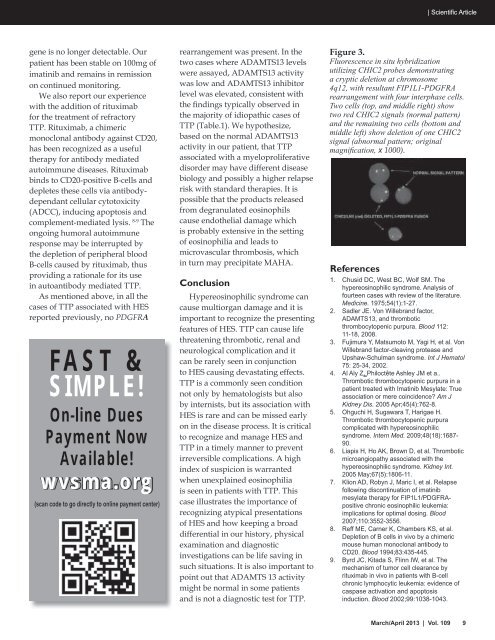March/April - West Virginia State Medical Association
March/April - West Virginia State Medical Association
March/April - West Virginia State Medical Association
Create successful ePaper yourself
Turn your PDF publications into a flip-book with our unique Google optimized e-Paper software.
| Scientific Article<br />
gene is no longer detectable. Our<br />
patient has been stable on 100mg of<br />
imatinib and remains in remission<br />
on continued monitoring.<br />
We also report our experience<br />
with the addition of rituximab<br />
for the treatment of refractory<br />
TTP. Rituximab, a chimeric<br />
monoclonal antibody against CD20,<br />
has been recognized as a useful<br />
therapy for antibody mediated<br />
autoimmune diseases. Rituximab<br />
binds to CD20-positive B-cells and<br />
depletes these cells via antibodydependant<br />
cellular cytotoxicity<br />
(ADCC), inducing apoptosis and<br />
complement-mediated lysis. 8-9 The<br />
ongoing humoral autoimmune<br />
response may be interrupted by<br />
the depletion of peripheral blood<br />
B-cells caused by rituximab, thus<br />
providing a rationale for its use<br />
in autoantibody mediated TTP.<br />
As mentioned above, in all the<br />
cases of TTP associated with HES<br />
reported previously, no PDGFRA<br />
Fast &<br />
Simple!<br />
On-line Dues<br />
Payment Now<br />
Available!<br />
wvsma.org<br />
(scan code to go directly to online payment center)<br />
rearrangement was present. In the<br />
two cases where ADAMTS13 levels<br />
were assayed, ADAMTS13 activity<br />
was low and ADAMTS13 inhibitor<br />
level was elevated, consistent with<br />
the findings typically observed in<br />
the majority of idiopathic cases of<br />
TTP (Table.1). We hypothesize,<br />
based on the normal ADAMTS13<br />
activity in our patient, that TTP<br />
associated with a myeloproliferative<br />
disorder may have different disease<br />
biology and possibly a higher relapse<br />
risk with standard therapies. It is<br />
possible that the products released<br />
from degranulated eosinophils<br />
cause endothelial damage which<br />
is probably extensive in the setting<br />
of eosinophilia and leads to<br />
microvascular thrombosis, which<br />
in turn may precipitate MAHA.<br />
Conclusion<br />
Hypereosinophilic syndrome can<br />
cause multiorgan damage and it is<br />
important to recognize the presenting<br />
features of HES. TTP can cause life<br />
threatening thrombotic, renal and<br />
neurological complication and it<br />
can be rarely seen in conjunction<br />
to HES causing devastating effects.<br />
TTP is a commonly seen condition<br />
not only by hematologists but also<br />
by internists, but its association with<br />
HES is rare and can be missed early<br />
on in the disease process. It is critical<br />
to recognize and manage HES and<br />
TTP in a timely manner to prevent<br />
irreversible complications. A high<br />
index of suspicion is warranted<br />
when unexplained eosinophilia<br />
is seen in patients with TTP. This<br />
case illustrates the importance of<br />
recognizing atypical presentations<br />
of HES and how keeping a broad<br />
differential in our history, physical<br />
examination and diagnostic<br />
investigations can be life saving in<br />
such situations. It is also important to<br />
point out that ADAMTS 13 activity<br />
might be normal in some patients<br />
and is not a diagnostic test for TTP.<br />
Figure 3.<br />
Fluorescence in situ hybridization<br />
utilizing CHIC2 probes demonstrating<br />
a cryptic deletion at chromosome<br />
4q12, with resultant FIP1L1-PDGFRA<br />
rearrangement with four interphase cells.<br />
Two cells (top, and middle right) show<br />
two red CHIC2 signals (normal pattern)<br />
and the remaining two cells (bottom and<br />
middle left) show deletion of one CHIC2<br />
signal (abnormal pattern; original<br />
magnification, x 1000).<br />
References<br />
1. Chusid DC, <strong>West</strong> BC, Wolf SM. The<br />
hypereosinophilic syndrome. Analysis of<br />
fourteen cases with review of the literature.<br />
Medicine. 1975;54(1):1-27.<br />
2. Sadler JE. Von Willebrand factor,<br />
ADAMTS13, and thrombotic<br />
thrombocytopenic purpura. Blood 112:<br />
11-18, 2008.<br />
3. Fujimura Y, Matsumoto M, Yagi H, et al. Von<br />
Willebrand factor-cleaving protease and<br />
Upshaw-Schulman syndrome. Int J Hematol<br />
75: 25-34, 2002.<br />
4. Al Aly Z, Philoctête Ashley JM et a..<br />
Thrombotic thrombocytopenic purpura in a<br />
patient treated with Imatinib Mesylate: True<br />
association or mere coincidence? Am J<br />
Kidney Dis. 2005 Apr;45(4):762-8.<br />
5. Ohguchi H, Sugawara T, Harigae H.<br />
Thrombotic thrombocytopenic purpura<br />
complicated with hypereosinophilic<br />
syndrome. Intern Med. 2009;48(18):1687-<br />
90.<br />
6. Liapis H, Ho AK, Brown D, et al. Thrombotic<br />
microangiopathy associated with the<br />
hypereosinophilic syndrome. Kidney Int.<br />
2005 May;67(5):1806-11.<br />
7. Klion AD, Robyn J, Maric I, et al. Relapse<br />
following discontinuation of imatinib<br />
mesylate therapy for FIP1L1/PDGFRApositive<br />
chronic eosinophilic leukemia:<br />
implications for optimal dosing. Blood<br />
2007;110:3552-3556.<br />
8. Reff ME, Carner K, Chambers KS, et al.<br />
Depletion of B cells in vivo by a chimeric<br />
mouse human monoclonal antibody to<br />
CD20. Blood 1994;83:435-445.<br />
9. Byrd JC, Kitada S, Flinn IW, et al. The<br />
mechanism of tumor cell clearance by<br />
rituximab in vivo in patients with B-cell<br />
chronic lymphocytic leukemia: evidence of<br />
caspase activation and apoptosis<br />
induction. Blood 2002;99:1038-1043.<br />
<strong>March</strong>/<strong>April</strong> 2013 | Vol. 109 9















